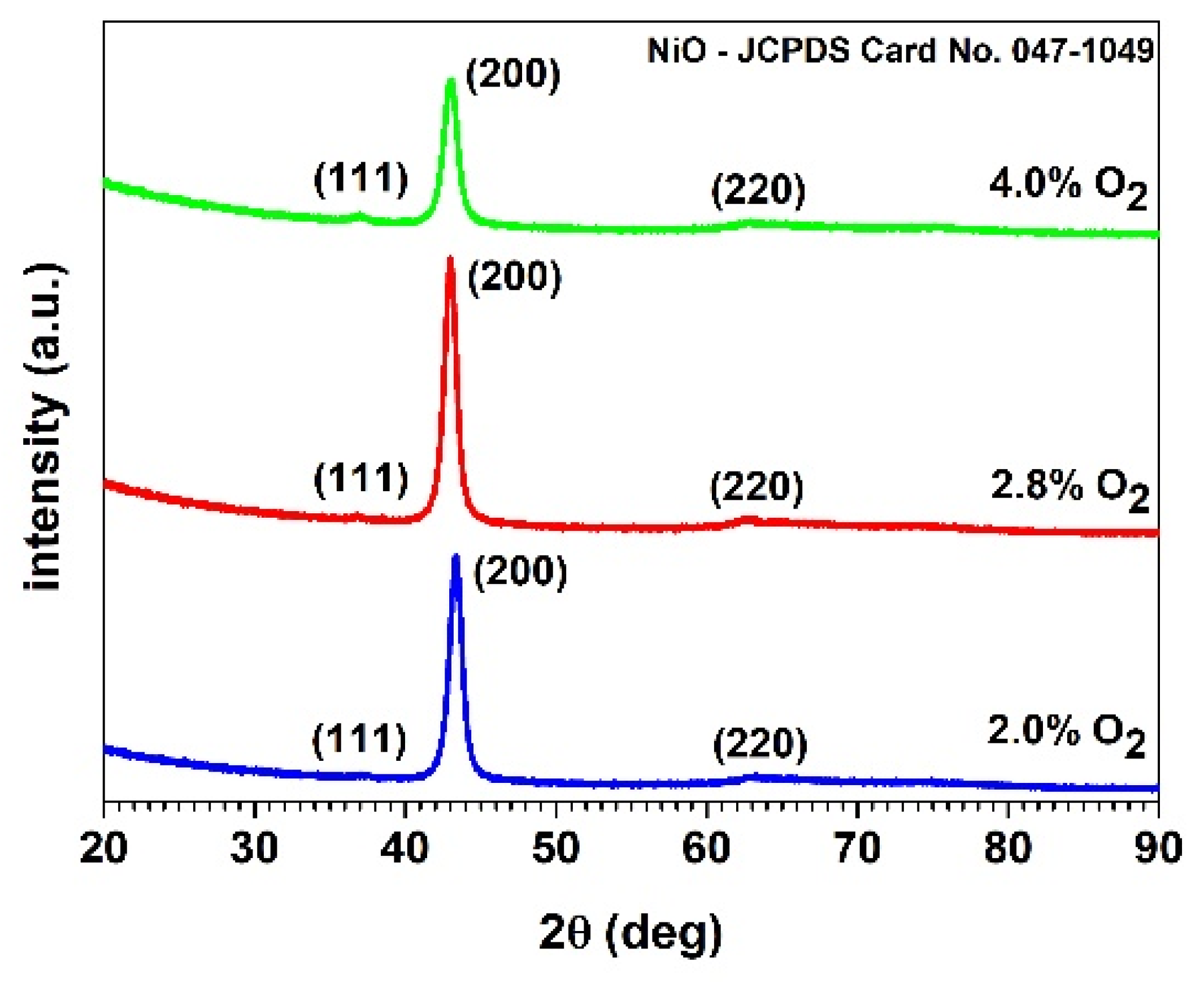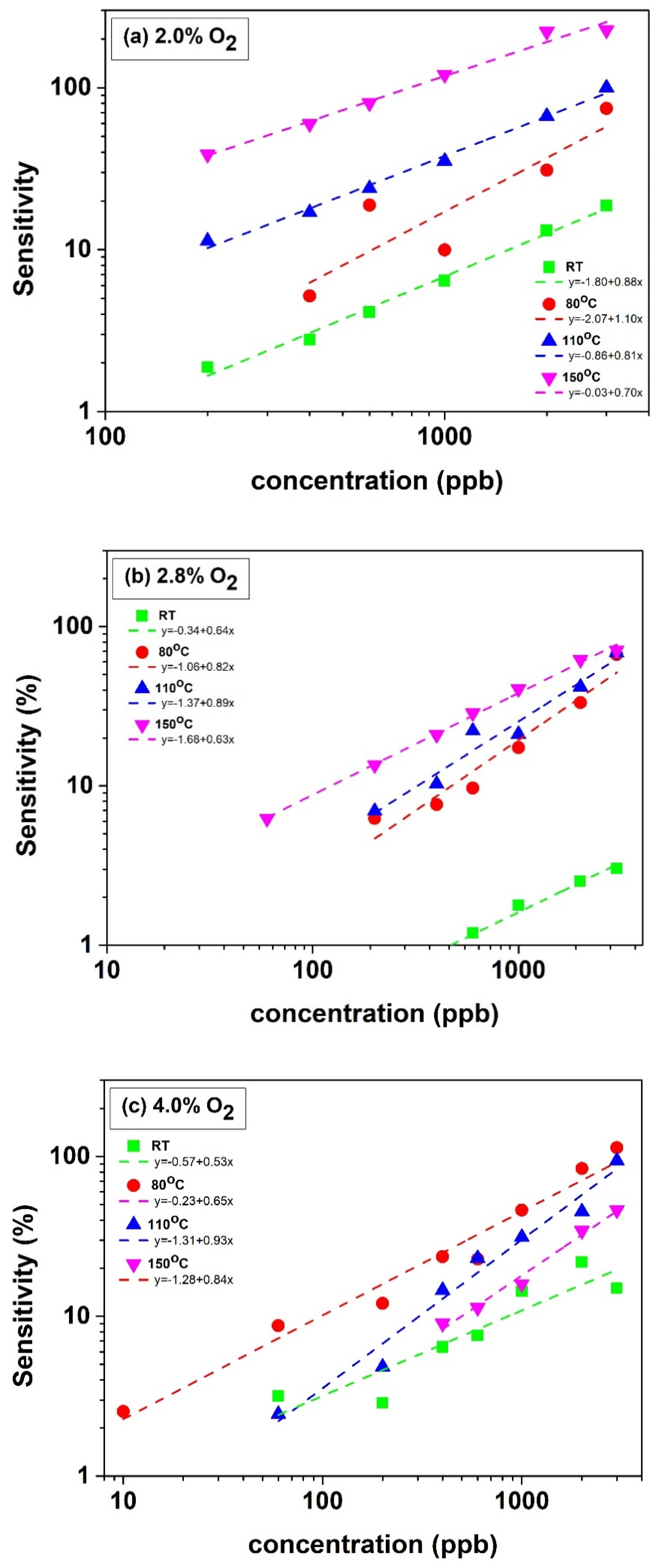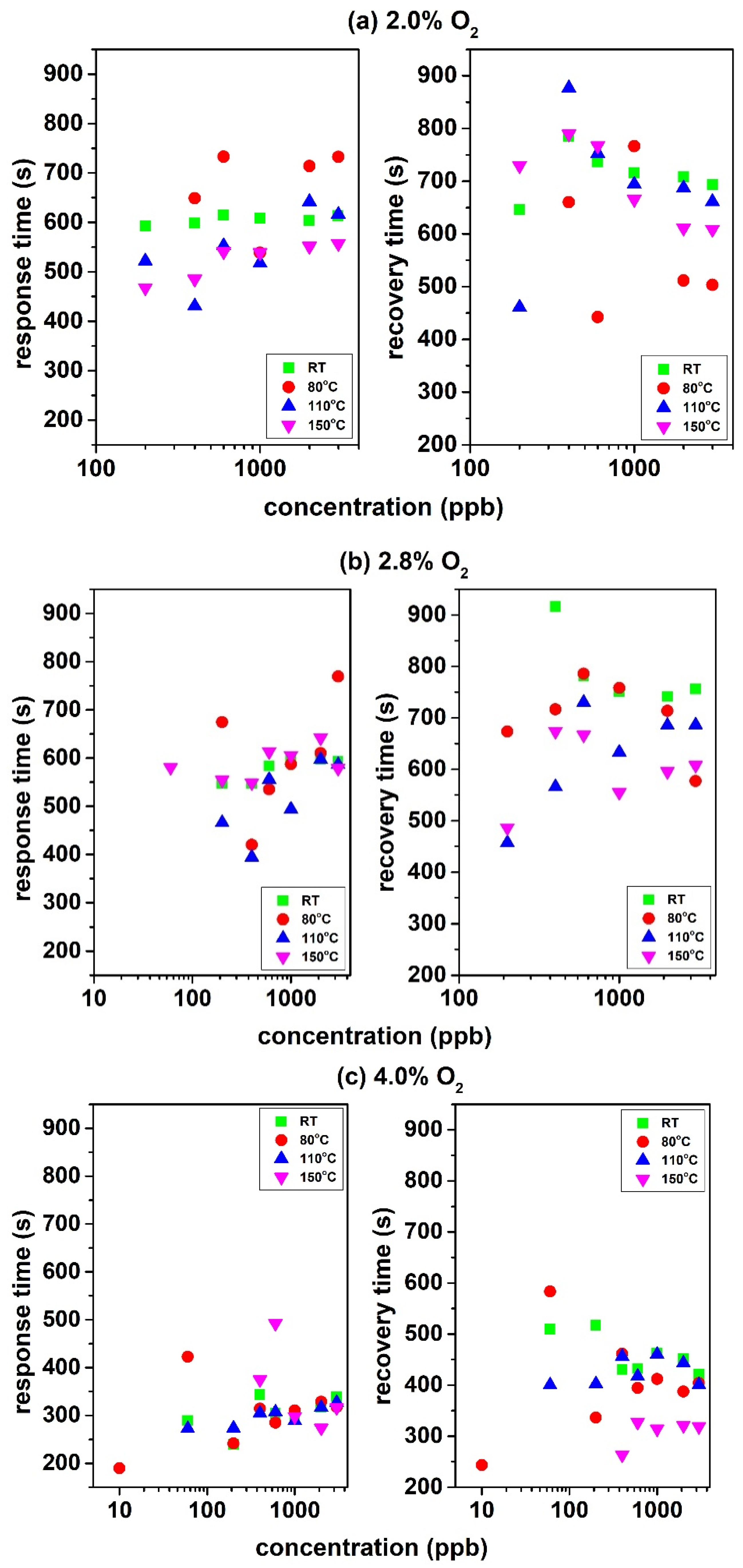Study on the Ozone Gas Sensing Properties of rf-Sputtered Al-Doped NiO Films
Abstract
Featured Application
Abstract
1. Introduction
2. Materials and Methods
2.1. Deposition Conditions
2.2. Characterization
2.3. Gas Sensing
3. Results and Discussion
3.1. Characterization
3.2. Gas Sensing
4. Conclusions
Author Contributions
Funding
Institutional Review Board Statement
Informed Consent Statement
Data Availability Statement
Conflicts of Interest
References
- Huangfu, P.; Atkinson, R. Long-term exposure to NO2 and O3 and all-cause and respiratory mortality: A systematic review and meta-analysis. Environ. Int. 2020, 144, 105998. [Google Scholar] [CrossRef]
- Barkjohn, K.K.; Norris, C.; Cui, X.; Fang, L.; Zheng, T.; Schauer, J.J.; Li, Z.; Zhang, Y.; Black, M.; Zhang, J.; et al. Real-time measurements of PM 2.5 and ozone to assess the effectiveness of residential indoor air filtration in Shanghai homes. Indoor Air 2021, 31, 74–87. [Google Scholar] [CrossRef]
- Bejaoui, A.; Guerin, J.; Zapien, J.; Aguir, K. Theoretical and experimental study of the response of CuO gas sensor under ozone. Sens. Actuators B Chem. 2014, 190, 8–15. [Google Scholar] [CrossRef]
- Rocha, L.; Foschini, C.; Silva, C.; Longo, E.; Simões, A. Novel ozone gas sensor based on ZnO nanostructures grown by the microwave-assisted hydrothermal route. Ceram. Int. 2016, 42, 4539–4545. [Google Scholar] [CrossRef]
- Petromichelaki, E.; Gagaoudakis, E.; Moschovis, K.; Tsetseris, L.; Anthopoulos, T.D.; Kiriakidis, G.; Binas, V. Highly sensitive and room temperature detection of ultra-low concentrations of O3 using self-powered sensing elements of Cu2O nanocubes. Nanoscale Adv. 2019, 1, 2009–2017. [Google Scholar] [CrossRef]
- Brintakis, K.; Gagaoudakis, E.; Kostopoulou, A.; Faka, V.; Argyrou, A.; Binas, V.; Kiriakidis, G.; Stratakis, E. Ligand-free all-inorganic metal halide nanocubes for fast, ultra-sensitive and self-powered ozone sensors. Nanoscale Adv. 2019, 1, 2699–2706. [Google Scholar] [CrossRef]
- Kakavelakis, G.; Gagaoudakis, E.; Petridis, K.; Petromichelaki, V.; Binas, V.; Kiriakidis, G.; Kymakis, E. Solution Processed CH3NH3PbI3–xClxPerovskite Based Self-Powered Ozone Sensing Element Operated at Room Temperature. ACS Sens. 2018, 3, 135–142. [Google Scholar] [CrossRef] [PubMed]
- Wetchakun, K.; Samerjai, T.; Tamaekong, N.; Liewhiran, C.; Siriwong, C.; Kruefu, V.; Wisitsoraat, A.; Tuantranont, A.; Phanichphant, S. Semiconducting metal oxides as sensors for environmentally hazardous gases. Sens. Actuators B Chem. 2011, 160, 580–591. [Google Scholar] [CrossRef]
- Moseley, P.T. Progress in the development of semiconducting metal oxide gas sensors: A review. Meas. Sci. Technol. 2017, 28, 082001. [Google Scholar] [CrossRef]
- Reddy, A.M.; Reddy, A.S.; Lee, K.-S.; Reddy, P.S. Effect of oxygen partial pressure on the structural, optical and electrical properties of sputtered NiO films. Ceram. Int. 2011, 37, 2837–2843. [Google Scholar] [CrossRef]
- Echresh, A.; Chey, C.O.; Shoushtari, M.Z.; Khranovskyy, V.; Nour, O.; Willander, M. UV photo-detector based on p-NiO thin film/n-ZnO nanorods heterojunction prepared by a simple process. J. Alloys Compd. 2015, 632, 165–171. [Google Scholar] [CrossRef]
- Bonomo, M.; Naponiello, G.; Venditti, I.; Zardetto, V.; Di Carlo, A.; Dini, D. Electrochemical and Photoelectrochemical Properties of Screen-Printed Nickel Oxide Thin Films Obtained from Precursor Pastes with Different Compositions. J. Electrochem. Soc. 2016, 164, H137–H147. [Google Scholar] [CrossRef]
- Di Girolamo, D.; Matteocci, F.; Piccinni, M.; Di Carlo, A.; Dini, D. Anodically electrodeposited NiO nanoflakes as hole selective contact in efficient air processed p-i-n perovskite solar cells. Sol. Energy Mater. Sol. Cells 2020, 205, 110288. [Google Scholar] [CrossRef]
- Di Girolamo, D.; Di Giacomo, F.; Matteocci, F.; Marrani, A.G.; Dini, D.; Abate, A. Progress, highlights and perspectives on NiO in perovskite photovoltaics. Chem. Sci. 2020, 11, 7746–7759. [Google Scholar] [CrossRef]
- Bonomo, M.; Dini, D.; Decker, F. Electrochemical and Photoelectrochemical Properties of Nickel Oxide (NiO) With Nanostructured Morphology for Photoconversion Applications. Front. Chem. 2018, 6, 601. [Google Scholar] [CrossRef] [PubMed]
- Bonomo, M.; Sheehan, S.; Dowling, D.P.; Gontrani, L.; Dini, D. First Evidence of Electrode Reconstruction in Mesoporous NiO After Operation as Photocathode of Dye-Sensitized Solar Cells. ChemistrySelect 2018, 3, 6729–6736. [Google Scholar] [CrossRef]
- Sahu, D.; Lee, Y.-H.; Wu, T.-J.; Wang, S.-C.; Huang, J.-L. Synthesis and electrochromic property improvement of NiO films for device applications. Thin Solid Films 2020, 707, 138097. [Google Scholar] [CrossRef]
- Sarkar, K.; Debnath, A.; Deb, K.; Bera, A.; Saha, B. Effect of NiO incorporation in charge transport of polyaniline: Improved polymer based thermoelectric generator. Energy 2019, 177, 203–210. [Google Scholar] [CrossRef]
- Nakate, U.T.; Ahmad, R.; Patil, P.; Yu, Y.; Hahn, Y.-B. Ultra thin NiO nanosheets for high performance hydrogen gas sensor device. Appl. Surf. Sci. 2020, 506, 144971. [Google Scholar] [CrossRef]
- Gagaoudakis, E.; Michail, G.; Kampylafka, V.; Tsagaraki, K.; Aperathitis, E.; Moschovis, K.; Binas, V.; Kiriakidis, G. Room Temperature p-Type NiO Nanostructure Thin Film Sensor for Hydrogen and Methane Detection. Sens. Lett. 2017, 15, 663–667. [Google Scholar] [CrossRef]
- Zhang, S.; Li, Y.; Sun, G.; Zhang, B.; Wang, Y.; Cao, J.; Zhang, Z. Enhanced methane sensing properties of porous NiO nanaosheets by decorating with SnO2. Sens. Actuators B Chem. 2019, 288, 373–382. [Google Scholar] [CrossRef]
- Urso, M.; Leonardi, S.G.; Neri, G.; Petralia, S.; Conoci, S.; Priolo, F.; Mirabella, S. Room temperature detection and modelling of sub-ppm NO2 by low-cost nanoporous NiO film. Sens. Actuators B Chem. 2020, 305, 127481. [Google Scholar] [CrossRef]
- Su, C.; Zhang, L.; Han, Y.; Ren, C.; Chen, X.; Hu, J.; Zeng, M.; Hu, N.; Su, Y.; Zhou, Z.; et al. Controllable synthesis of crescent-shaped porous NiO nanoplates for conductometric ethanol gas sensors. Sens. Actuators B Chem. 2019, 296, 126642. [Google Scholar] [CrossRef]
- Demin, V.S.; Krasovskii, A.N.; Lyudchik, A.M.; Pokatashkin, V.I.; Grigorishin, I.L.; Kudanovich, O.N. Measurement of ozone over a wide range of concentrations using semiconductor NiO gas sensors. Meas. Tech. 2008, 51, 1038–1044. [Google Scholar] [CrossRef]
- Nandy, S.; Maiti, U.N.; Ghosh, C.K.; Chattopadhyay, K.K. Enhanced p-type conductivity and band gap narrowing in heavily Al doped NiO thin films deposited by RF magnetron sputtering. J. Phys. Condens. Matter 2009, 21, 115804. [Google Scholar] [CrossRef]
- Wang, S.; Huang, D.; Xu, S.; Jiang, W.; Wang, T.; Hu, J.; Hu, N.; Su, Y.; Zhang, Y.; Yang, Z. Two-dimensional NiO nanosheets with enhanced room temperature NO2 sensing performance via Al doping. Phys. Chem. Chem. Phys. 2017, 19, 19043–19049. [Google Scholar] [CrossRef] [PubMed]
- Kampitakis, V.; Gagaoudakis, E.; Zappa, D.; Comini, E.; Aperathitis, E.; Kostopoulos, A.; Kiriakidis, G.; Binas, V. Highly sensitive and selective NO2 chemical sensors based on Al doped NiO thin films. Mater. Sci. Semicond. Process. 2020, 115, 105149. [Google Scholar] [CrossRef]
- Wang, C.; Cui, X.; Liu, J.; Zhou, X.; Cheng, X.; Sun, P.; Hu, X.; Li, X.; Zheng, J.; Lu, G. Design of Superior Ethanol Gas Sensor Based on Al-Doped NiO Nanorod-Flowers. ACS Sens. 2016, 1, 131–136. [Google Scholar] [CrossRef]
- Abdul-Hussein, Y.M.; Ali, H.J.; Latif, L.A.; Abdulsattar, M.A.; Fadhel, H.M. Preparation of Al-Doped NiO Thin Films by Spray Pyrolysis Technique for CO Gas Sensing. J. Adv. Pharm. Educ. Res. 2019, 9, 1–6. [Google Scholar]
- Gagaoudakis, E.; Michail, G.; Katerinopoulou, D.; Moschovis, K.; Iliopoulos, E.; Kiriakidis, G.; Binas, V.; Aperathitis, E. Transparent p-type NiO:Al thin films as room temperature hydrogen and methane gas sensors. Mater. Sci. Semicond. Process. 2020, 109, 104922. [Google Scholar] [CrossRef]
- Siddique, M.N.; Ahmed, A.; Tripathi, P. Electric transport and enhanced dielectric permittivity in pure and Al doped NiO nanostructures. J. Alloys Compd. 2018, 735, 516–529. [Google Scholar] [CrossRef]
- Liu, L.; Li, T.; Yi, Z.; Chi, F.; Lin, Z.; Zhang, X.; Xu, K. Conductometric ozone sensor based on mesoporous ultrafine Co3O4 nanobricks. Sens. Actuators B Chem. 2019, 297, 126815. [Google Scholar] [CrossRef]
- Mokoena, T.P.; Swart, H.C.; Motaung, D.E. A review on recent progress of p-type nickel oxide based gas sensors: Future perspectives. J. Alloys Compd. 2019, 805, 267–294. [Google Scholar] [CrossRef]
- Sun, Q.; Wu, Z.; Cao, Y.; Guo, J.; Long, M.; Duan, H.; Jia, D. Chemiresistive sensor arrays based on noncovalently functionalized multi-walled carbon nanotubes for ozone detection. Sens. Actuators B Chem. 2019, 297, 126689. [Google Scholar] [CrossRef]
- Onofre, Y.J.; Catto, A.C.; Bernardini, S.; Fiorido, T.; Aguir, K.; Longo, E.; Mastelaro, V.R.; da Silva, L.F.; de Godoy, M.P. Highly selective ozone gas sensor based on nanocrystalline Zn0.95Co0.05O thin film obtained via spray pyrolysis technique. Appl. Surf. Sci. 2019, 478, 347–354. [Google Scholar] [CrossRef]
- Wu, C.-H.; Jiang, G.-J.; Chang, K.-W.; Deng, Z.-Y.; Li, Y.-N.; Chen, K.-L.; Jeng, C.-C. Analysis of the Sensing Properties of a Highly Stable and Reproducible Ozone Gas Sensor Based on Amorphous In-Ga-Zn-O Thin Film. Sensors 2018, 18, 163. [Google Scholar] [CrossRef] [PubMed]
- Catto, A.C.; Da Silva, L.F.; Ribeiro, C.; Bernardini, S.; Aguir, K.; Longo, E.; Mastelaro, V.R. An easy method of preparing ozone gas sensors based on ZnO nanorods. RSC Adv. 2015, 5, 19528–19533. [Google Scholar] [CrossRef]
- Joshi, N.; Da Silva, L.F.; Jadhav, H.; M’Peko, J.-C.; Torres, B.B.M.; Aguir, K.; Mastelaro, V.R.; Oliveira, O.N. One-step approach for preparing ozone gas sensors based on hierarchical NiCo2O4 structures. RSC Adv. 2016, 6, 92655–92662. [Google Scholar] [CrossRef]








| Sample No. | % O2 in Plasma | %at. Al | t (nm) | D (nm) | a0 (nm) | Eg (eV) |
|---|---|---|---|---|---|---|
| S1749 | 2.0 | 5.3 | 160.3 | 8.68 | 0.417 | 3.66 |
| S1746 | 2.8 | 6.5 | 168.7 | 8.68 | 0.421 | 3.65 |
| S1743 | 4.0 | 6.7 | 167.5 | 7.89 | 0.420 | 3.66 |
| Sample No. | % O2 in Plasma | Toper (°C) | Minimum Detected Concentration (ppb) | S (%) |
|---|---|---|---|---|
| S1749 | 2.0 | RT | 213 | 1.88 |
| 80 | 393 | 5.17 | ||
| 110 | 213 | 11.31 | ||
| 150 | 207 | 38.66 | ||
| S1746 | 2.8 | RT | 393 | 0.84 |
| 80 | 212 | 6.25 | ||
| 110 | 215 | 6.94 | ||
| 150 | 67 | 6.22 | ||
| S1743 | 4.0 | RT | 58 | 3.18 |
| 80 | 13 | 2.54 | ||
| 110 | 59 | 2.44 | ||
| 150 | 330 | 9.02 |
Publisher’s Note: MDPI stays neutral with regard to jurisdictional claims in published maps and institutional affiliations. |
© 2021 by the authors. Licensee MDPI, Basel, Switzerland. This article is an open access article distributed under the terms and conditions of the Creative Commons Attribution (CC BY) license (https://creativecommons.org/licenses/by/4.0/).
Share and Cite
Paralikis, A.; Gagaoudakis, E.; Kampitakis, V.; Aperathitis, E.; Kiriakidis, G.; Binas, V. Study on the Ozone Gas Sensing Properties of rf-Sputtered Al-Doped NiO Films. Appl. Sci. 2021, 11, 3104. https://doi.org/10.3390/app11073104
Paralikis A, Gagaoudakis E, Kampitakis V, Aperathitis E, Kiriakidis G, Binas V. Study on the Ozone Gas Sensing Properties of rf-Sputtered Al-Doped NiO Films. Applied Sciences. 2021; 11(7):3104. https://doi.org/10.3390/app11073104
Chicago/Turabian StyleParalikis, Athanasios, Emmaouil Gagaoudakis, Viktoras Kampitakis, Elias Aperathitis, George Kiriakidis, and Vassilios Binas. 2021. "Study on the Ozone Gas Sensing Properties of rf-Sputtered Al-Doped NiO Films" Applied Sciences 11, no. 7: 3104. https://doi.org/10.3390/app11073104
APA StyleParalikis, A., Gagaoudakis, E., Kampitakis, V., Aperathitis, E., Kiriakidis, G., & Binas, V. (2021). Study on the Ozone Gas Sensing Properties of rf-Sputtered Al-Doped NiO Films. Applied Sciences, 11(7), 3104. https://doi.org/10.3390/app11073104








